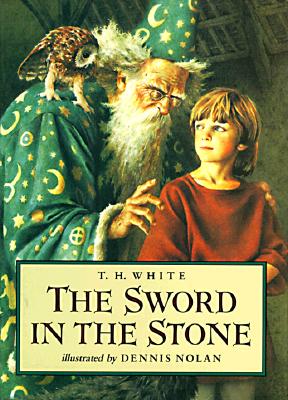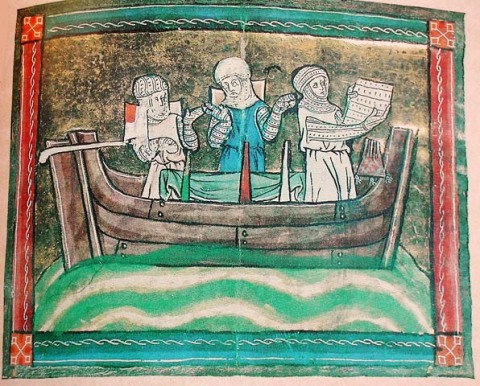
When a few years back I told my mum I was writing a story about Pythagoras, she said why not pick someone British to write about? Merlin, she suggested.
It would be hard to do after T. H. White’s classic Sword in the Stone, which Sam is reading now.
He does need a little help though with some of the difficult bits. I need some help with some of the difficult bits. Take this, which must be one of the hardest passages to take a breath in in children’s literature, the description of Merlin’s room:
It was the most marvellous room that he had ever been in.
There was a real corkindrill hanging from the rafters, very life-like and horrible with glass eyes and scaly tail stretched out behind it. When its master came into the room it winked one eye in salutation, although it was stuffed. There were thousands of brown books in leather bindings, some chained to the book-shelves and others propped against each other as if they had had too much to drink and did not really trust themselves. These gave out a smell of must and solid brownness which was most secure. Then there were stuffed birds, popinjays, and maggot-pies and kingfishers, and peacocks with all their feathers but two, and tiny birds like beetles, and a reputed phoenix which smelt of incense and cinnamon. It could not have been a real phoenix, because there is only one of these at a time. Over by the mantelpiece there was a fox’s mask, with GRAFTON, BUCKINGHAM TO DAVENTRY, 2 HRS 20 MINS written under it, and also a forty-pound salmon with AWE, 43 MIN., BULLDOG written under it, and a very life-like basilisk with CROWHURST OTTER HOUNDS in Roman print. There were several boars’ tusks and the claws of tigers and libbards mounted in symmetrical patterns, and a big head of Ovis Poli, six live grass snakes in a kind of aquarium, some nests of the solitary wasp nicely set up in a glass cylinder, an ordinary beehive whose inhabitants went in and out of the window unmolested, two young hedgehogs in cotton wool, a pair of badgers which immediately began to cry Yik-Yik-Yik-Yik in loud voices as soon as the magician appeared, twenty boxes which contained stick caterpillars and sixths of the puss-moth, and even an oleander that was worth sixpence — all feeding on the appropriate leaves — a guncase with all sorts of weapons which would not be invented for half a thousand years, a rod-box ditto, a chest of drawers full of salmon flies which had been tied by Merlyn himself, another chest whose drawers were labelled Mandragora, Mandrake, and Old Man’s Beard, etc., a bunch of turkey feathers and goose-quills for making pens, an astrolabe, twelve pairs of boots, a dozen purse-nets, three dozen rabbit wires, twelve corkscrews, some ants’ nests between two glass plates, ink-bottles of every possible colour from red to violet, darning-needles, a gold medal for being the best scholar at Winchester, four or five recorders, a nest of field mice all alive-o, two skulls, plenty of cut glass, Venetian glass, Bristol glass and a bottle of Mastic varnish, some satsuma china and some cloisonné, the fourteenth edition of the Encyclopaedia Britannica (marred as it was by the sensationalism of the popular plates), two paint-boxes (one oil, one water-colour), three globes of the known geographical world, a few fossils, the stuffed head of a cameleopard, six pismires, some glass retorts with cauldrons, bunsen burners, etc., and a complete set of cigarette cards depicting wild fowl by Peter Scott.
I didn’t type all this out – it was on another blog. In fact it doesn’t matter too much that I’m not quite sure about them, perhaps it even makes it better, not to be quite sure what these things are. A bit like the famous poem The Jabberwocky.
 reading the story of
reading the story of 















